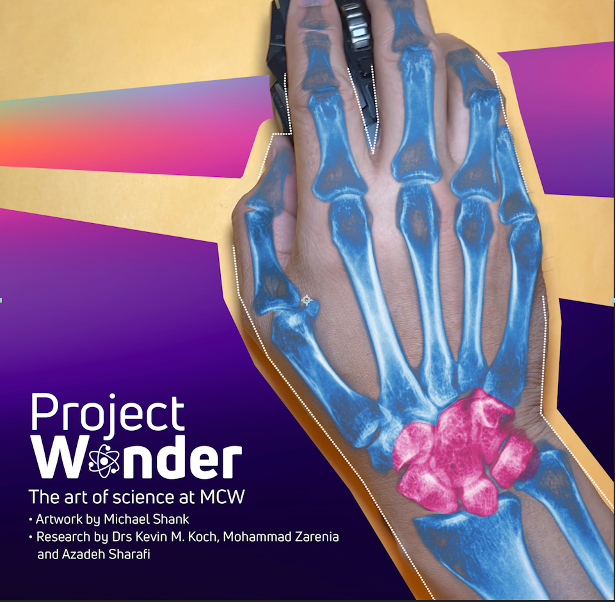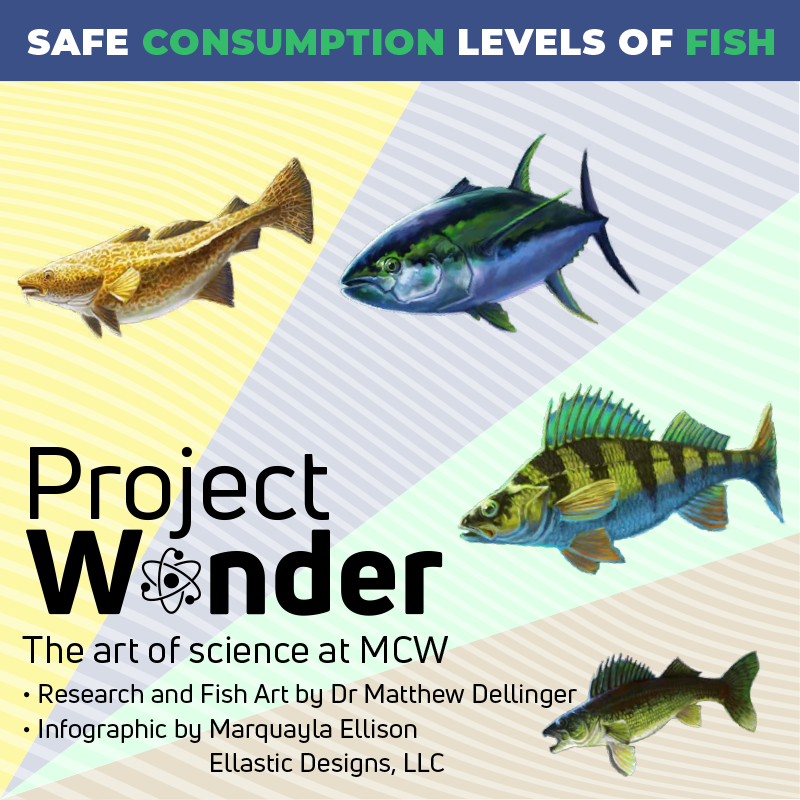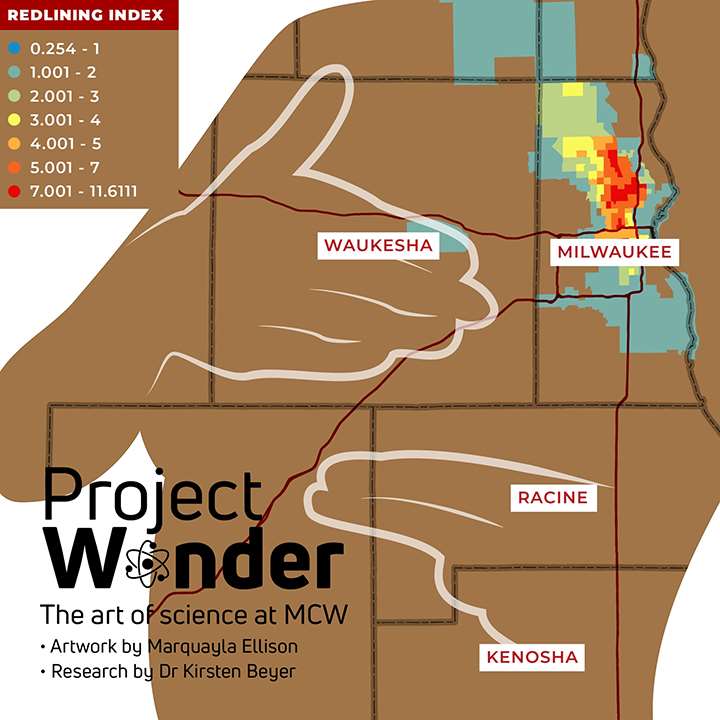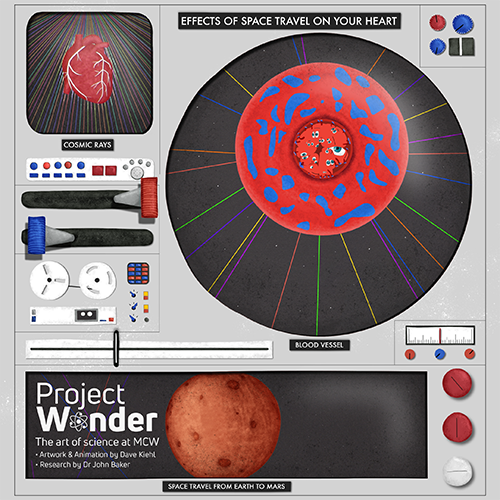Learn more about the power of the synergy of art and science
By Meisi Li
Artists creating innovative work need sufficient room to maneuver and flexibility in how they use their materials and media. Project Wonder, an initiative launched by the Medical College of Wisconsin, provides this room for artists to express their creativity through various media forms. As you navigate through this article, prepare to be enchanted by the seamless harmony between science and art, where research takes on vibrant forms and artistic expressions unlock new dimensions of understanding. You can also see how these art projects help people better understand scientific research, from a virus in the human body to heart health in the universe.
Mixed-media animation: “Tracking the Flick of a Wrist”

Using advanced scanning technology and cutting-edge data analysis methods, orthopedic and medical imaging experts from the Medical College of Wisconsin are exploring innovative ways to capture the dynamic behavior of the carpal row in the wrist. This approach is poised to enable clinicians to more precisely identify the origins of pain and discomfort associated with wrist movements, particularly when it comes to diagnosing issues linked to specific ligaments in the wrist. While further research is necessary to refine this technique in treating patients, researchers say these early findings represent a promising step toward a future where dynamic wrist scans may replace static ones, potentially enhancing diagnostic accuracy and patient care.
Michael Shank has produced a compelling and innovative animated video for this advancement. The animation combines real images with CT scanning to show the audience how dynamic scanning technology can capture the complex movements of the wrist bones.
Infographic: “Eating ‘Our Fish’ Safely”

The Anishinaabe communities in the Great Lakes region face the dual challenge of protecting their cherished cultural practice of fish consumption and addressing the threats posed by chemical contaminants like mercury. They’re working with national, state and academic partners to form a powerful alliance. Matthew Dellinger, an associate professor of epidemiology at the Medical College of Wisconsin, spearheaded the creation of the Gigiigoo’inaan app, a technological marvel that not only educates users about safe fish consumption but also promotes the health benefits of fish rich in omega-3 fatty acids.
Marquayla Ellison’s artistic contribution to the collaborative project is an engaging and straightforward infographic. This artwork distills the invaluable recommendations of the researchers involved in the initiative, offering concise guidance on safe fish consumption tailored to someone’s age, gender and weight. This infographic serves as a practical tool for promoting healthier dietary choices within Anishinaabe communities while maintaining cultural reverence for fish as a staple food.
Data map: “Redlining, Race, Bias, and Breast Cancer”

In the quest to combat the glaring disparities in breast cancer rates and their devastating impact on various communities, scientists at the Medical College of Wisconsin have embarked on a groundbreaking project that fuses data mapping with a critical examination of neighborhood characteristics. This innovative approach delves deep into the intricate web of socioeconomic status, racial segregation, home ownership and walkability to unravel the intricate tapestry of factors that contribute to cancer rates and survivorship.
Marquayla Ellison’s powerful artwork, titled “Redlining, Race, Bias, and Breast Cancer,” serves as a striking visual representation of a complex issue. Through meticulous research data, Ellison has crafted a map that vividly highlights the intertwining dynamics of race, bias and health care disparities within specific geographic regions, notably Milwaukee, Waukesha, Racine, Kenosha and Walworth counties. What makes this artwork truly impactful is the seamless fusion of statistical information with artistic expression. Within this meticulously detailed map, one can discern the outline of a woman performing a breast self-exam, a tool that can help detect breast cancer early on and a poignant symbol of the intimate and deeply personal nature of the healthcare challenges faced by communities of color.
Graphic design animation: “Space Travel and Heart Health”

As mankind explores space beyond our planet, a pressing issue looms — the impact of galactic cosmic rays on astronaut health. John Baker, a distinguished professor of surgery, biochemistry, and pharmacology and toxicology at the Medical College of Wisconsin, collaborated with NASA to investigate the question of how these cosmic rays affect the human heart. Through a series of experiments involving rats as proxies for early to mid-career astronauts, the research team exposed these subjects to high-energy ion beams mimicking galactic cosmic rays. The outcomes of this study unveiled a worrisome development: the rats showed increased collagen around their blood vessels and high blood pressure over a nine-month period after exposure to the rays.
Dave Kiehl’s captivating art piece offers a unique and visually engaging perspective on the physiological effects of space travel on the human heart. Through the medium of animation, Kiehl illustrates the intricate journey of the heart as it navigates the challenges of space. In this visually striking panel, the narrative unfolds across multiple dimensions. At the bottom, a spacecraft embarks on its voyage from Earth to Mars, capturing the essence of space exploration. In the upper left corner, the heart portrays the intricate dance of space-borne challenges as it encounters galactic cosmic rays on its interstellar path. On the right, a compelling visualization of the heart’s response emerges, with a notable increase in collagen around its delicate blood vessels.